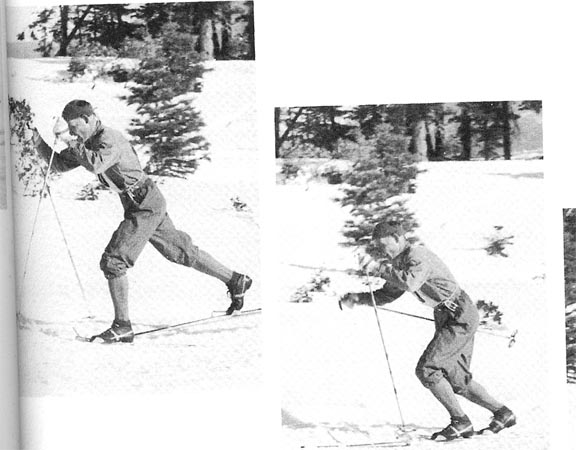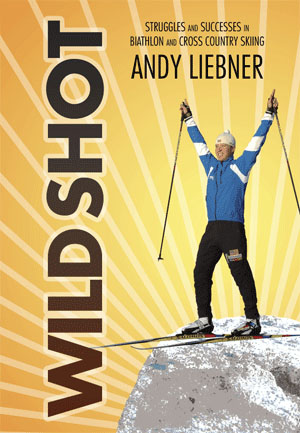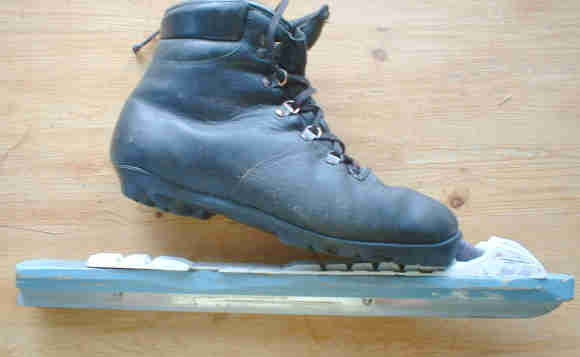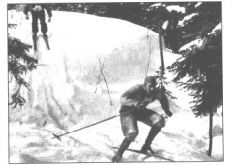My impression is that many casual-type XC skiers feel a bit lost with their technique. It’s because they’ve been taught (and shown) race-based methods — but they aren’t racers. Race-type tech is needed sometimes (uphills), but other moves are needed, too — maybe even more so.
Thankfully, such moves are available. Sadly, they’re unknown. Thankfully, some skiers develop them for themselves. Sadly, they wonder if they’re doing something wrong and they don’t always figure out where each kind works best.
These simple, fun, natural moves mostly come from the old wood-ski days when people skied with stout equipment on homemade trails. …Which is how most people still ski today! Yet these moves aren’t really taught anywhere except here!
In fact, the info you’re about to read promotes the biggest changes in classic-type skiing in decades! They’re geared to touring-type dayskiers, but even racers are benefitting. Check it out!
Get ready to finally get comfy on skis! (I posted most of this in my “XC for Everyone” article, but can’t leave well enough alone. This post emphasizes the surprisingly vital new/old moves.)
TOURING’S ANCHOR MOVE
Touring’s biggest trick is the way most everyday skiers eventually learn to ski on their own, naturally. I call it the Delayed Diagonal stride (DD), but maybe it should be the Touring Stride. It’s a variant step that tourists and dayskiers use in flat terrain and it goes with their upright posture. Here’s how it works: a skier stands up, nice and tall, reaches out, and poles. As the pole goes past their hip, they kick or step. The arm is shoved straight down and back, about 6-10 inches past the hip. To get a good kick there’s a fair bit of up and down bobbing in the knees and the arms go out and forward a bit like Frankenstein. Anyway, that’s it!
Here’s why it’s a good thing: the DD is a low-energy way to ski. It lets your skis do what they’re designed to do: you stand on a ski and it guides you down the trail. You ride it, not boss it. That’s why for your everyday skiing you want a wide, stable, mellow touring ski and not a squirrelly, narrow, stiff race ski.
The DD doesn’t use a complete weight transfer; if it does, it’s brief. And that’s fine. It gives enough grip/kick for flat terrain. This is also why a softer camber is nice for everyday skiing: you can’t kick real hard from an upright position. In effect, there’s a bit of a telemark position briefly because the kicking foot hits the trail again behind the gliding foot. This is good. The telemark is designed for stability. The pole plant is vertical, out in front, and somewhat to the side — this also gives stability. These traits give tourists the stability they need to have fun and do sightseeing, chatting, on uneven homestyle trails. It’s also handy for carrying a pack, as you’re not bent over.
Sadly, this is not a method that’s taught anywhere and it’s pretty much always labeled as incorrect. (Let’s see if I get any heat for pushing bad advice on unwitting noobs.)
To go faster or up a slight hill, you can advance the touring DD a half-beat. That is, don’t reach out with such a long arm. Use a bent arm and a close pole-plant. This can help you bring your kick and pole timing TOGETHER which lets you get more weight transfer, better propulsion angles, and much better grip. As a hill gets steeper, you’ll have to flex and bob more deeply to get enough grip. You can still use an upright posture and you still might not have total weight transfer or pole follow-thru, but you can kick’n’glide up some hills this way.
ENTER THE RACER…
As the trail tilts upward, the DD finally won’t give enough grip no matter how you play it. Then the time comes to use the Racing Diagonal for easy, efficient traction. This move is taught in every class, but here’s my take… Drop into your ankles and flex them deeply. Plant the poles with arms bent and hands near shoulders, don’t reach forward much. Bring the pole and kick timing TOGETHER. Don’t shove your foot far forward. You’re reining in your style, compressing and compacting it. This gives you enough grip to let you easily jump from foot to foot and get as much glide as the slope will allow.
On flatter terrain if you can keep this tasty efficiency by just lengthening out your arms a bit — still keep them bent and plant the poles near your feet. Still keep a fair bit of flex in your ankle. Hump or curl your shoulders forward, look at the ground 8 feet in front of you — but raise your eyes. Shove your gliding foot farther forward and glide on your heel, then kick off your whole foot. As you pole, tilt your body forward and pole to the rear until your arm is straight — it’ll swing past you quite a ways. This kind of skiing uses different muscle groups. It also uses 100% weight transfer from foot to foot. It’s fast and glides the best. It’s not the best way to look around or to carry a pack, but the DD can tire out your lower back after awhile so it’s good to know all the moves to rest your muscles as you go.
Racers do two other moves that are taught everywhere and which you won’t use often as a dayskier on homestyle trails: the doublepole and kick-doublepole. They’re not so hot for sightseeing or socializing and they’re best for fast, stable/groomed trails and slight downhills. They’re a nice change-of-pace where suitable. In fact, I have little to add to the common how-to info about them, except a couple observations: they should maybe be called “two foot gliding” moves because you glide with your feet side-by-side — not so stable, but interesting in light of what I’ll tell you soon. Feet-together DP moves also result in a LOT of torso-bobbing and up’n’down motion — it’s powerful poling that uses your body-weight. However, you often want to work less. And both are quite bad for carrying packs. Thankfully, good news is coming up a few points from now. 🙂
When a hill is steepest of all, you have to herringbone, a common move. But if you’re skiing up a gullied-out hill, you simply can’t do that. Instead, do this nifty move which isn’t taught anywhere: a shuffling side-step with downward “tilted” skis up one side of the gully. What I mean is, you’re not going up the side of the gully and out over the rim, you’re using the side to go up the hill — the side goes AWAY from the hill, you want to go ALONG it. So, lift your tails a lot as you go, so it feels like you’re pointing your tips downward. Get it? Groomed trails don’t see such gullies, but everyday skiers encounter them all the time on hiking trails.
On fast downhills, or when the trail gets tricky, use the Standard Dynamic Athletic Posture: Hands low and in front; knees and ankles flexed deeply; weight a bit forward. This way you can quickly move from foot to foot to get around corners or keep from falling.
People sometimes ask me about basic cornering and control. This is well taught many places, but here’s my take: being able to shift your weight from foot to foot is the key. Weighting and unweighting through standing tall then dropping down is the other key. Practice stepping your skis around and making an asterix in the snow on a flat place. To turn on a downhill you step from foot to foot toward the inside, often with a skating motion. To turn on an uphill you kick and glide as usual only you swing the tails out as you go around the turn, keeping the tips pointing where you want to go. To control speed or do skidding turns you stand up, unweighting your skis, then you drop down and put a ski or two out at an angle and weight them and skid them on edge — you can do a snowplow or skid-turn this way. But this is easy stuff. On to the coolest stuff of all!
TWO MORE GEARS!
Dayskiers can also add the Two-Step Doublepole (2SDP) and the Pendulum Step to their flat terrain repertoire. I’m hereby reviving these moves from the era of wood skis.
In the 2SDP you use an upright posture and you step once, step again, then double pole. Try it! It’s diagonal striding with a doublepole! (DSDP? DDP?) You don’t throw yourself onto your poles and follow-through all the way with torso crunching down — this is a moderate move, for moderate skiing. The torso stays steady! It’s great for sightseeing and it’s stable on an uneven trail. …And many of you are already doing it. (So I’m not really reviving it, just putting it into print and giving it respect.) I’ve heard tourers laugh at themselves for doing it, thinking it’s a mistake, since it’s not in any how-to info — well, it’s the real deal. Keep it up!
Now, it has a couple variants, both well worth knowing. As you step onto a ski to kick you can doublepole right then: that’s called the Cat1. The kick and two poleplants hit at the same time. It’s actually darn good for skiing up hills. Or, you can step onto a ski while your hands are swinging forward, glide on that ski a bit, DP down then step off it. So you have a rise and fall on the pole-side kicking ski — this is a faster move for more glide and less grip, called the Cat1A. Maybe you’ve guessed that these variants of the 2SDP come from the skating world. You’re right! They’re just V1 and V1A only they’re done with the skis pointing straight forward and getting grip. You can even do these moves with a set of longer skating poles. And people are now even racing with these moves! They were developed by the guy who makes Cat skis, hence the names. See more at catskier.blogspot.com.
These moves give you the support and stability of using two poles while giving you the ease of striding. They’re far easier to do than the “official” DP and KDP when on homestyle trails.
In fact, you’ll find that you can have just as much fun skiing on un-tracked trails as on groomed trails. With less weight-commitment it’s easier to keep your skis behaved so you don’t need the deep grooves to go straight. Track-setting is a HUGE overhead and barrier for XC-skiing. These moves make it, dare I say, irrelevant? I mean, sure, keep it for the specialists who want to drive to their skiing — tracks do offer the best glide, after all, and are suitable for the lightest of skis. But glide is relative. Mostly, I want to help folks ski nicely anywhere there’s snow!
Then there’s the Pendulum Step. This is 2SDP or DS with a delayed pole-plant. You use an upright posture, taking two steps then pumping your poles in front of you before planting them. Get it? You swing your baskets forward of your grips then let them float back into a mellow doublepole that uses an upright posture. In the Diagonal Pendulum you scissor the poles while striding, then plant the same pole again as what you last poled with (frankly, I haven’t worked out the details of this oldschool move). The P-2SDP is often just a great-feeling move; it’s mellow, for a trail with good glide. It’s VERY upright in posture. I was doing it a lot the other while skiing in with a group — I could stand upright and see the trail amidst everyone yet not run up on anyone. Penduluming your poles also lets you make smooth transitions as a trail winds around or goes over little humps — that’s not so critical with ultralight gear on a fast track, but with everyday-type equipment on a softer, slower track, while carrying a bit more weight, it can really add up. You want to keep your flow.
So don’t limit yourself. Let your rhythm roll. Play with timings as you like. You’re the boss. Now that I’ve been playing more with these moves I can’t believe I haven’t always relied on them. 2/3rd’s of the “official” repetoire — DP and KDP — just aren’t very handy for casual trails. The 2SDP moves can sometimes totally replace them! At any rate, these new moves can provide a fun break or variety. Playing around with beats lets you see what’s really going on when you ski.
Isn’t it cool? You now have, like, 10 gears — if you count the Pendulum variants. With the official manual you only have 4! And 3 are geared mostly to racing and groomed tracks!
Extra moves, transitions and change-ups used to be a bigger part of skiing. With today’s lightweight gear citizen racers just doublepole up to a hill then change into striding as best they can, meaning they sometimes flounder a bit. Racing transitions happen so fast that it doesn’t always matter much (for non-Olympians, anyway).
For tourists, “interesting” trail conditions make up a much larger part of an outing. That’s because they’re on fun trails!
Mt-bikers prize twisty, narrow trails as rare singletrack where handling skills are rewarded. It’s the same in skiing! But in mtbiking, good singletrack is rare. In skiing, great trails are EVERYWHERE! In the old days even racers were in this kind of situation and their equipment was heavier, so they learned (and taught) a wide variety of beats and transitions.
It’s time to bring ’em all back to life!





